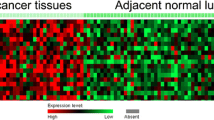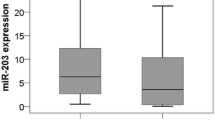Abstract
The abnormal expression of microRNA-221 was detected in several cancers and some studies had indicated that microRNA-221 was associated with cancer prognosis. This study was aimed to evaluate the prognostic significance of microRNA-221 in non-small cell lung cancer (NSCLC). Quantitative real-time polymerase chain reaction (qRT-PCR) was used for detecting the relative expression levels of microRNA-221 in the pathological tissues and corresponding normal tissues of 104 NSCLC patients. The relationship between the expression levels and the clinical features was estimated by Chi-square method and the overall survival of patients at different expression levels was demonstrated by Kaplan-Meier method. Cox regression analysis was used to evaluate the prognostic significance of microRNA-221. The relative expression levels of microRNA-221 in the pathological tissues were remarkably higher than that in the corresponding normal tissues (1.71 vs 1.07, P = 0.000). The expression level was associated with lymph node metastasis (P = 0.001). The results of Kaplan-Meier method indicated that patients with high expression level of microRNA-221 had shorter overall survival time than those with low expression level (36.8 vs 45.2 months, P = 0.001). Moreover, Cox regression analysis suggested that microRNA-221 was a useful independent biomarker for NSCLC prognosis (HR = 1.873, 95 % CI = 1.267-2.768, P = 0.002). The aberrant expression of microRNA-221 is associated with NSCLC progression and it might be a potential biomarker for NSCLC prognosis.


Similar content being viewed by others
References
Jemal A, Bray F, Center MM, Ferlay J, Ward E, Forman D. Global cancer statistics. CA Cancer J Clin. 2011;61(2):69–90. doi:10.3322/caac.20107.
Sher T, Dy GK, Adjei AA. Small cell lung cancer. Mayo Clin Proc. 2008;83(3):355–67. doi:10.4065/83.3.355.
Molina JR, Yang P, Cassivi SD, Schild SE, Adjei AA. Non-small cell lung cancer: epidemiology, risk factors, treatment, and survivorship. Mayo Clin Proc. 2008;83(5):584–94. doi:10.4065/83.5.584.
Ettinger DS, Wood DE, Akerley W, Bazhenova LA, Borghaei H, Camidge DR, et al. Non-small cell lung cancer, version 6.2015. J Natl Compr Cancer Netw. 2015;13(5):515–24.
Fujiwara Y, Hotta K, Di Maio M, Kiura K, Takigawa N, Tabata M, et al. Time trend in treatment-related deaths of patients with advanced non-small-cell lung cancer enrolled into phase III trials of systemic treatment. Ann Oncol. 2011;22(2):376–82. doi:10.1093/annonc/mdq360.
Hotta K, Kiura K, Fujiwara Y, Takigawa N, Hisamoto A, Ichihara E, et al. Role of survival post-progression in phase III trials of systemic chemotherapy in advanced non-small-cell lung cancer: a systematic review. PLoS One. 2011;6(11):e26646. doi:10.1371/journal.pone.0026646.
Ke Z, He W, Lai Y, Guo X, Chen S, Li S, et al. Overexpression of collagen triple helix repeat containing 1 (CTHRC1) is associated with tumour aggressiveness and poor prognosis in human non-small cell lung cancer. Oncotarget. 2014;5(19):9410–24.
Bartel DP. MicroRNAs: genomics, biogenesis, mechanism, and function. Cell. 2004;116(2):281–97.
Simonson B, Das S. MicroRNA therapeutics: the next magic bullet? Mini Rev Med Chem. 2015;15(6):467–74.
Chung AC, Lan HY. MicroRNAs in renal fibrosis. Front Physiol. 2015;6:50. doi:10.3389/fphys.2015.00050.
Yan S, Cao Y, Mao A. MicroRNAs in colorectal cancer: potential biomarkers and therapeutic targets. Front Biosci (Landmark Ed). 2015;20:1092–103.
Anwar SL, Lehmann U. DNA methylation, microRNAs, and their crosstalk as potential biomarkers in hepatocellular carcinoma. World J Gastroenterol. 2014;20(24):7894–913. doi:10.3748/wjg.v20.i24.7894.
Yang F, Zhang W, Shen Y, Guan X. Identification of dysregulated microRNAs in triple-negative breast cancer (review). Int J Oncol. 2015;46(3):927–32. doi:10.3892/ijo.2015.2821.
Ke J, Zhao Z, Hong SH, Bai S, He Z, Malik F, et al. Role of microRNA221 in regulating normal mammary epithelial hierarchy and breast cancer stem-like cells. Oncotarget. 2015;6(6):3709–21.
Qin J, Luo M. MicroRNA-221 promotes colorectal cancer cell invasion and metastasis by targeting RECK. FEBS Lett. 2014;588(1):99–104. doi:10.1016/j.febslet.2013.11.014.
Sun X, Liu B, Zhao XD, Wang LY, Ji WY. MicroRNA-221 accelerates the proliferation of laryngeal cancer cell line Hep-2 by suppressing Apaf-1. Oncol Rep. 2015;33(3):1221–6. doi:10.3892/or.2015.3714.
Xu Y, Zhong C, Ding S, Huang H, Shen Z. MicroRNA-221 promotes human non-small cell lung cancer cell H460 growth. Int J Clin Exp. 2015;8(2):2024–30.
Brighenti M. MicroRNA and MET in lung cancer. Ann Transl Med. 2015;3(5):68. doi:10.3978/j.issn.2305-5839.2015.01.26.
Nicoloso MS, Spizzo R, Shimizu M, Rossi S, Calin GA. MicroRNAs—the micro steering wheel of tumour metastases. Nat Rev Cancer. 2009;9(4):293–302. doi:10.1038/nrc2619.
Peng Y, Dong W, Lin TX, Zhong GZ, Liao B, Wang B, et al. MicroRNA-155 promotes bladder cancer growth by repressing the tumor suppressor DMTF1. Oncotarget. 2015;6(18):16043–58.
Liu S, Pan X, Yang Q, Wen L, Jiang Y, Zhao Y, et al. MicroRNA-18a enhances the radiosensitivity of cervical cancer cells by promoting radiation-induced apoptosis. Oncol Rep. 2015;33(6):2853–62. doi:10.3892/or.2015.3929.
Sun L, Bian G, Meng Z, Dang G, Shi D, Mi S. MiR-144 inhibits uveal melanoma cell proliferation and invasion by regulating c-Met expression. PLoS One. 2015;10(5):e0124428. doi:10.1371/journal.pone.0124428.
Yu J, Tan Q, Deng B, Fang C, Qi D, Wang R. The microRNA-520a-3p inhibits proliferation, apoptosis and metastasis by targeting MAP3K2 in non-small cell lung cancer. Am J Cancer Res. 2015;5(2):802–11.
Wang F, Lou JF, Cao Y, Shi XH, Wang P, Xu J, et al. miR-638 is a new biomarker for outcome prediction of non-small cell lung cancer patients receiving chemotherapy. Exp Mol Med. 2015;47:e162. doi:10.1038/emm.2015.17.
Liu X, Shi H, Liu B, Li J, Liu Y, Yu B. miR-330-3p controls cell proliferation by targeting early growth response 2 in non-small-cell lung cancer. Acta Biochim Biophys Sin. 2015;47(6):431–40. doi:10.1093/abbs/gmv032.
Yang T, Thakur A, Chen T, Yang L, Lei G, Liang Y, et al. MicroRNA-15a induces cell apoptosis and inhibits metastasis by targeting BCL2L2 in non-small cell lung cancer. Tumour Biol. 2015;36(6):4357–65. doi:10.1007/s13277-015-3075-1.
Xie Z, Cai L, Li R, Zheng J, Wu H, Yang X, et al. Down-regulation of miR-489 contributes into NSCLC cell invasion through targeting SUZ12. Tumour Biol. 2015;36(8):6497–505. doi:10.1007/s13277-015-3340-3.
Chen D, Guo W, Qiu Z, Wang Q, Li Y, Liang L, et al. MicroRNA-30d-5p inhibits tumour cell proliferation and motility by directly targeting CCNE2 in non-small cell lung cancer. Cancer Lett. 2015;362(2):208–17. doi:10.1016/j.canlet.2015.03.041.
Yamashita R, Sato M, Kakumu T, Hase T, Yogo N, Maruyama E, et al. Growth inhibitory effects of miR-221 and miR-222 in non-small cell lung cancer cells. Cancer Med. 2015;4(4):551–64. doi:10.1002/cam4.412.
Fabbri M. miRNAs as molecular biomarkers of cancer. Expert Rev Mol Diagn. 2010;10(4):435–44. doi:10.1586/erm.10.27.
Zhang Y, Li H, Han J. Down-regulation of microRNA-124 is correlated with tumor metastasis and poor prognosis in patients with lung cancer. Int J Clin Exp Pathol. 2015;8(2):1967–72.
Yuan B, Liang Y, Wang D, Luo F. MiR-940 inhibits hepatocellular carcinoma growth and correlates with prognosis of hepatocellular carcinoma patients. Cancer Sci. 2015;106(7):819–24. doi:10.1111/cas.12688.
Wang H, Men CP. Correlation of increased expression of microRNA-155 in bladder cancer and prognosis. Lab Med. 2015;46(2):118–22. doi:10.1309/LMWR9CEA2K2XVSOX.
Author information
Authors and Affiliations
Corresponding author
Ethics declarations
Conflicts of interest
None
Rights and permissions
About this article
Cite this article
Zhang, Y., Zhao, Y., Sun, S. et al. Overexpression of MicroRNA-221 is associated with poor prognosis in non-small cell lung cancer patients. Tumor Biol. 37, 10155–10160 (2016). https://doi.org/10.1007/s13277-015-4662-x
Received:
Accepted:
Published:
Issue Date:
DOI: https://doi.org/10.1007/s13277-015-4662-x




